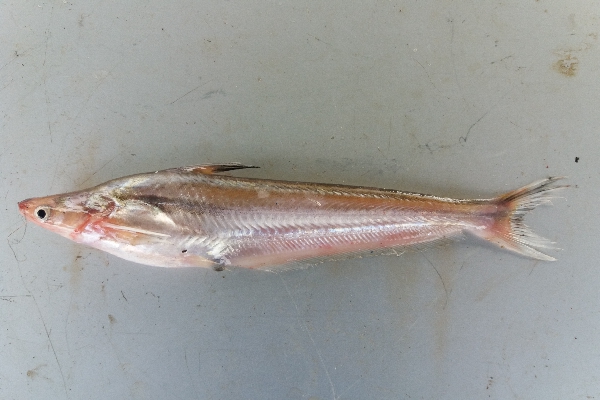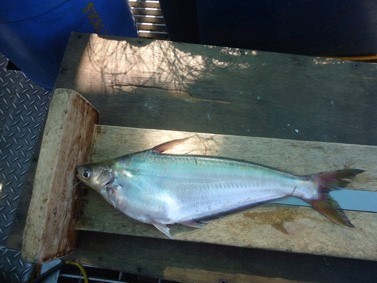Common names:
Silver catfish, Butter Catfish, or Butterfish
Lunyoro: Karakogere Central Uganda: Nzere
Taxonomic tree
Kingdom: Animalia
Phylum: Chordata
Class: Actinopterygii (ray-finned fish)
Order: Siluriformes (Catfish)
Family: Schilbeidae (African Butter Catfishes)
Genus: Schilbe
Species: Schilbe intermedius (Rüppell, 1832)
Number of Occurrancies: 235
Etymology(based on Sharpf & Lazara, 2017)
- Schilbe: latinization of “Les Schilbé” used by Cuvier in 1816, based on a local name for S. mystus along the Nile River
- intermedius: meaning in between (i.e. in reference to possession if intermediate characters between S. uranoscopus and Siluranodon auritus (then placed in Schilbe))
Synonyms: click here to view synonyms
Type locality: Lower Nile River, Egypt. Syntypes at the British Museum of Natural History (BMNH)
Distinguishing characters for the genus
- Scaleless, moderately elongate and strongly (laterally) compressed body
- Short dorsal fin comprising a spine and 5 or 6 branched rays, with no adipose fin
- Very long anal fin, extending from the vent almost to the origin of the caudal fin
Distinguishing characters for the species (only 1 species is common in Ugandan waters)
- Large shovel mouth surrounded by four pairs of short circum-oral barbels, with the eyes slightly protruding from head.
- Colour is Silver-grey, somewhat darker above.
- The young are marked with three longitudinal black bands, the upper ad lower of which are continued onto the caudal fin.
Taxonomic notes: This species highly resembles Schilbe mystus (Linnaeus, 1758), the African butter catfish, which is possibly extant in the Nile basin, excepth that S. mystus has a small adipose fin.
Distribution in Uganda: Lakes Victoria, Kyoga, Nabugabo and Albert; the Victoria Nile, Semliki and Aswa rivers
Occurence: Native
Habitat: Pelagic; common in inshore areas, but also found in and open waters; potamodromous.
Feeding: Primarily piscivorous at 10 cm total length and above; principally feeds on small fishes (especially haplochromines) although insects larvae are also eaten.
Biology: Schilbe intermedius rarely grows larger than 30 cm standard length, but generally attains 11-13 cm fork length (FL) at the begining of the secod year. Generally spawns throughout the year, peaking once and migrates into the tributaries of rivers and streamsrivers in fairly compact schools during the rainy season to spawn in floodwater pools. Sexually dimorphic with females growing to a larger size than males. It may also exibit diurnal vertical migration to the surface at night. About 10% of the population matures between 11 and 14 cm FL. Fecundity ranges between 18,000 and 45,000 eggs.
Economic importance/End use: The species is not specifically targeted by fisheries; incidental catches are mainly used for food. The flesh is very palatable and makes good eating. Preparation for human food is mainly by boiling or smoking.
IUCN conservation status: click here to view IUCN status
Threats: Lakes Victoria and Kyoga populations severely reduced due to predation and /or competitive displacement by introduced fishes Nile perch.
Main references
- Greenwood PH. 1966. The fishes of Uganda. The Uganda Society, Kampala. 131 pages.
- Sharpf C, Lazara J.K. 2017. Fish Name Etymology Database v13. www.etyfish.org
- Witte F & van Densen W.L.T. 1995. Fish Stocks and Fisheries of Lake Victoria: a handbook for field observations. Samara Publishing Limited, Netherlands



